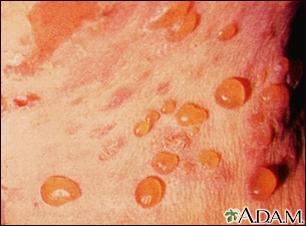Bullous pemphigoid
Bullous pemphigoid is a skin disorder characterized by blisters.
Images

I Would Like to Learn About:
Causes
Bullous pemphigoid is an autoimmune disorder that occurs when the body's immune system attacks and destroys healthy body tissue by mistake. Specifically, the immune system attacks the proteins that attach the top layer of skin (epidermis) to the bottom layer of skin.
This disorder usually occurs in older persons and is rare in young people. Symptoms come and go. The condition often goes away within 5 years.
In some cases, the condition is triggered by a medicine.
Symptoms
Most people with this disorder have itchy skin that may be severe. In most cases, there are blisters, called bullae.
- Blisters are usually located on the arms, legs, or middle of the body. In rare cases, blisters can form in the mouth.
- The blisters may break open and form open sores (ulcers).
Exams and Tests
Your health care provider will examine the skin and ask about the symptoms. They will review your list of medicines.
Tests that may be done to help diagnose this condition include:
- Blood tests
- Skin biopsy of the blister or the area next to it
Treatment
Anti-inflammatory medicines called corticosteroids may be prescribed. They may be taken by mouth or applied to the skin. More powerful medicines may be used to help suppress the immune system if steroids do not work, or to allow lower steroid doses to be used.
Antibiotics in the tetracycline family may be useful. Niacin (a B complex vitamin) is sometimes given along with tetracycline.
Your provider may suggest self-care measures. These may include:
- Applying anti-inflammatory creams to the skin
- Using mild soaps and applying moisturizer to the skin after bathing
- Protecting the affected skin from sun exposure and injury
Outlook (Prognosis)
Bullous pemphigoid usually responds well to treatment. The medicine can often be stopped after several years. The disease sometimes returns after treatment is stopped.
Possible Complications
Skin infection is the most common complication.
Complications resulting from treatment may also occur, especially from taking corticosteroids.
When to Contact a Medical Professional
Contact your provider if you have:
- Unexplained blisters on your skin
- An itchy rash that continues despite home treatment
Related Information
VesiclesReferences
Bilgic A, Murrell DF. Bullous pemphigoid. In: Lebwohl MG, Heymann WR, Coulson IH, Murrell DF, eds. Treatment of Skin Disease: Comprehensive Therapeutic Strategies. 6th ed. Philadelphia, PA: Elsevier; 2022:chap 32.
Dinulos JGH. Vesicular and bullous diseases. In: Dinulos JGH, ed. Habif's Clinical Dermatology. 7th ed. Philadelphia, PA: Elsevier; 2021:chap 16.
BACK TO TOPReview Date: 5/31/2023
Reviewed By: Ramin Fathi, MD, FAAD, Director, Phoenix Surgical Dermatology Group, Phoenix, AZ. Also reviewed by David C. Dugdale, MD, Medical Director, Brenda Conaway, Editorial Director, and the A.D.A.M. Editorial team.

Health Content Provider
06/01/2025
|
A.D.A.M., Inc. is accredited by URAC, for Health Content Provider (www.urac.org). URAC's accreditation program is an independent audit to verify that A.D.A.M. follows rigorous standards of quality and accountability. A.D.A.M. is among the first to achieve this important distinction for online health information and services. Learn more about A.D.A.M.'s editorial policy, editorial process and privacy policy. A.D.A.M. is also a founding member of Hi-Ethics. This site complied with the HONcode standard for trustworthy health information from 1995 to 2022, after which HON (Health On the Net, a not-for-profit organization that promoted transparent and reliable health information online) was discontinued. |
The information provided herein should not be used during any medical emergency or for the diagnosis or treatment of any medical condition. A licensed medical professional should be consulted for diagnosis and treatment of any and all medical conditions. Links to other sites are provided for information only -- they do not constitute endorsements of those other sites. © 1997- 2025 A.D.A.M., a business unit of Ebix, Inc. Any duplication or distribution of the information contained herein is strictly prohibited.
